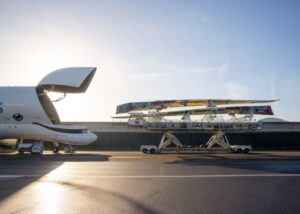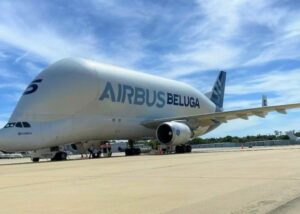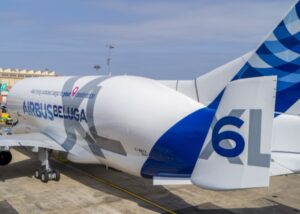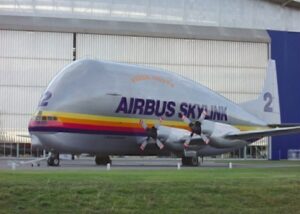It’s not only the sheer size of the Airbus Beluga aircraft that impresses us at Sentinel Aviation, but the feat of engineering to produce such an extraordinary aircraft.
The Beluga (based on the Airbus A300-600) has successfully carried an Airbus-made satellite from France to the United States.

The supersized cargo aircraft, registered as F-GSTF, landed at Orlando Sanford Airport on March 11, after stops in Portugal, Canada, and New Hampshire. The aircraft covered 4,525 nautical miles (8,382 kilometers).
Flying an Airbus-made satellite
According to Airbus, the Beluga carried the EUTELSAT 36D satellite to its launch site in Florida, the US, with the aircraft landing at Orlando Sanford International Airport (SFB) for its final stop on the journey.

The Beluga, registered as F-GSTF, took off from Toulouse Blagnac Airport (TLS) in France, landing at Terceira Lajes Airport (TER), Portugal, on March 10, 2024. Subsequently, it departed TER and crossed the ocean to St. John’s International Airport (YYT), Canada, on the following day before completing its journey by flying from YYT to Portsmouth International Airport (PSM) and finally to SFB on March 11.

This was Airbus Beluga Transport’s (AiBT) first mission to the United States as an independent company, which flies outsized cargo throughout the globe. The French Directorate General for Civil Aviation (Direction générale de l’aviation civile, DGAC) granted AiBT its Air Operator’s Certificate (AOC) on November 13, 2023.
While the Airbus Beluga is undoubtedly huge, the aircraft is still fairly limited in range. According to the manufacturer’s specifications page, the Beluga ST’s maximum range is 892 NMI (1,650 km), while the type-certificate data sheet (TCDS), published by the European Union Aviation Safety Agency (EASA), detailed the type’s maximum limitations further.
The TCDS’ specifications showed that the Airbus A300-600ST, the official type designation for the Beluga, has a maximum takeoff weight (MTOW) of 153,000 kilograms (337,307 pounds) or 155,000 kg (341,716 lbs). The former only applies to the Beluga, whose manufacturer serial number (MSN) is 655 and is registered as F-GSTA.

Meanwhile, the aircraft can carry up to 49,600 kg (109,349 lbs) of fuel in its three tanks, while the main cargo compartment is certified to have a maximum load of 45,500 kg (100,310 lbs). Three other cargo holds, namely aft, rear, and forward, can carry items. However, since the satellite weighed 5 tonnes (5,000 kg, 11,023 lbs), the Beluga could fly further between France and the US.
Upgrading to the BelugaXL
In January 2022, Airbus announced that the Belugas will be used to serve industrial customers across the globe, carrying their outsized cargo between locations. As a result, the A330-based BelugaXL fleet has taken over the duties of its predecessor, namely, carrying components between Airbus manufacturing sites.

In total, the European plane maker is utilizing six BelugaXLs for its manufacturing processes, flying between 11 sites in Europe. The upgraded outsized cargo aircraft is much more capable than its predecessor, as its range alone is a maximum of 2,200 NMI (4,000 km).
Why Has Airbus Built The BelugaXL Aircraft Type?
The Beluga aircraft, designed and produced by European manufacturer Airbus, is a large and uniquely shaped cargo transport aircraft that always catches the attention of those lucky enough to come across it.
Airbus began with the BelugaST and later launched the BelugaXL program to enhance its large cargo transport capacity. It is a distinctive cargo aircraft, modified from the A330, with an equally characteristic smiling whale appearance. Airbus operates the BelugaST and the larger BelugaXL to transport parts of its aircraft between construction and assembly sites, as this article explores.
Transporting Airbus Aircraft Parts
Airbus has its origins in the coming together of several European aviation firms. They joined to form the company in 1970. As part of the cross-European collaboration, aircraft manufacturing and assembly are split across several countries. This brings massive logistical challenges of shipping completed parts from one country to another for final assembly.
This was initially done by road and barge. Aircraft transportation was added in 1972 with a fleet of four modified Boeing Stratocruiser aircraft known as Super Guppies. Eventually, though, these aircraft needed replacing. They were old and inefficient to operate; more importantly, additional capacity was required.
Airbus introduced the Beluga cargo aircraft in 1995 as a replacement. It was based on the A300-600, with a significantly enlarged fuselage for cargo transport. While their primary role has been transporting Airbus aircraft components between European sites, they have also seen plenty of charter use, including carrying machinery, helicopters, and satellite parts.
Increased Demand and Larger Aircraft Parts
Five Beluga aircraft were delivered between 1995 and 1999. Four are still active today, while the first to be built was retired in 2021. The BelugaXL program was launched in 2014, and the aircraft performed its maiden flight in 2018. It was created to replace the aging BelugaST fleet and support the increased production of modern aircraft. Certification of the type came in November 2019, allowing it to enter service in January 2020.
As more aircraft would help Airbus meet growing transportation needs, the newer cargo plane came with critically higher capacity. The original Beluga can carry 103,617 lb (47,000 kg) in a freight compartment with a volume of 53,000 cu ft (1,500 cubic meters). The BelugaXL increases this to 111,333 lb (50,500 kg) with a volume of 78,000 cu ft.
Get in touch
© Sentinel Aviation. Company No. 09400896. Vat No. 221163359.
All rights reserved. Created by AJA Design.
